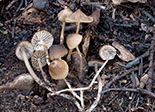Terrestrial, among mosses, wooden chips or humus, possibly connected to buried wood. Summer to autumn. Very rare. Known from France, Switzerland, Spain, Germany, The Netherlands, The Czech Republic, Poland, Denmark, Sweden, and Norway.
Pileus 5-18 mm wide, at first conical, becoming convex to plano-convex with a prominent, acute papilla, translucent-striate, hygrophanous, dark grey-brown to blackish when moist, sometimes paler at the margin, then cinereous to sepia-grey when drying, the papilla black, glabrous to slightly lubricous after rain, somewhat shiny and cartilaginous; margin sometimes crenulate in age. Lamellae (15-)18-25(-28) reaching the stipe, ascending, broadly adnate to sinuate notched, never decurrent, +/- basally interveined in age, whitish to pale grey; edge concolorous. Stipe 20-50 x 1-2(-3) mm, cartilaginous, cylindrical to compressed, minutely pruinose to glabrous, shiny, whitish to grey-ochraceous, +/- dark grey or pale brownish towards the base, rooting (up to 40 mm); base covered with numerous, long, white fibrils. Smell and taste insignificant.
Basidia (20-)25-40(-45) x 5.5-9 µm, clavate, 4-spored, rarely 2- or 1-spored, with sterigmata 2-6 µm long. Spores(7-)8-11(-13) x (5-)6-8(-9) µm, Q 1.3-2, Qav ~ 1.4-1.7 (4-spored form), variable shape, pip-shaped to broadly pip-shaped or somewhat amygdaliform, smooth, non-amyloid. Cheilocystidia (17-)21-49 x 2.5-7.5 µm, occurring mixed with basidia, but partly forming a sterile band, variable in shape, cylindrical to clavate or somewhat narrowly sub-fusiform, never ventricose, often curved or flexuous, smooth, simple, apically obtuse, or more rarely furcate or covered with lateral and apical, coarse excrescences. Pleurocystidia absent. Lamellar trama non- or weakly dextrinoid. Hyphae of the pileipellis 1-4.5 µm wide, irregularly covered with sparse, obtuse, simple to furcate or branched, sometimes curved excrescences 1-12 x 0.5-2.5 µm, with a tendency to become slightly gelatinized. Hyphae of the stipitipellis 1-4 µm wide, smooth; caulocystidia 1-6 µm wide, often in clusters, irregularly clavate, flexuous, smooth or sometimes branched apically. Clamps present in 4-spored form, but not numerous and hard to find, absent in 2-spored form.
Additional microscopic drawings.
The description has been taken from Kühner's account and Esteve-Raventós (1995), complemented by observations on five Norwegian collections.
Phloeomana atropapillata was formerly recognized as a member of Mycena section Hiemales Konrad & Maubl. subsection Hiemales on account of its ascendent, broadly adnate lamellae and non-amyloid spores. According to Esteve-Raventós (1995), the diagnostic characters of P. atropapillata are: 1) the prominent and black papilla, 2) the typical rooting stipe, which sometimes can be quite reduced, 3) the presence of a diverticulate pileipellis, 4) heterogeneous lamellar edge, 5) more or less cylindrical cheilocystidia, which are never ventricose, and 6) terrestrial habitat.
It seems to be rare all over Europe, and there are not many references to this species in the literature. Esteve-Raventós (1995) provided a comprehensive description, based on material from France, Switzerland and Spain. Contrary to Maas Geesteranus (1991), who never saw any material, he showed that the pileipellis of P. atropapillata is diverticulate, and in that aspect it comes close to P. hiemalis. The latter may also sometimes have a little umbo on the pileus and similar attachment of the lamellae. However, P. hiemalis usually is paler coloured, it grows directly on wood, and, above all, the cheilocystidia and caulocystidia are broader, typically ventricose. Kühner measured narrower spores. Esteve-Raventós too described the spores somewhat narrower than in the two Norwegian collections. The shape and size of the spores seem, however, to vary a lot in the Norwegian material.
Mycena radicifer Favre is possibly the same species. It was described by Favre in 1957, and was supposed to differ from P. atropapillata by 1) gills narrowly adnate to adnate, decurrent with a very short tooth, 2) hyphae of the pileipellis sparsely covered with simple to furcate or branched excrescences up to 35 µm long, 3) hyphae of the cortical layer of the stipe smooth, and 4) terminal cells coarsely diverticulate. Maas Geesteranus (1991) accepted both as separate species (although he did not see material of P. atropapillata) because P. atropapillata was considered as a species with smooth hyphae in the pileipellis and M. radicifer as a species with the hyphae diverticulate. Esteve-Raventòs (1995), however, showed that the pileipellis in P. atropapillata is diverticulate too.
Six ITS sequences of P. atropapillata obtained by the Norwegian Barcode project (NorBOL) are constituting two separate groups: one with 4-spored basidia and one with 2-spored basidia, indicating that they represent two different species. However, I cannot see other morphological differences between them. More material is needed before a conclusion ca be drawn.
 
Next image
Further images on the web:
Pilze München (as Mycena radicifer) 1 2 3 4
|